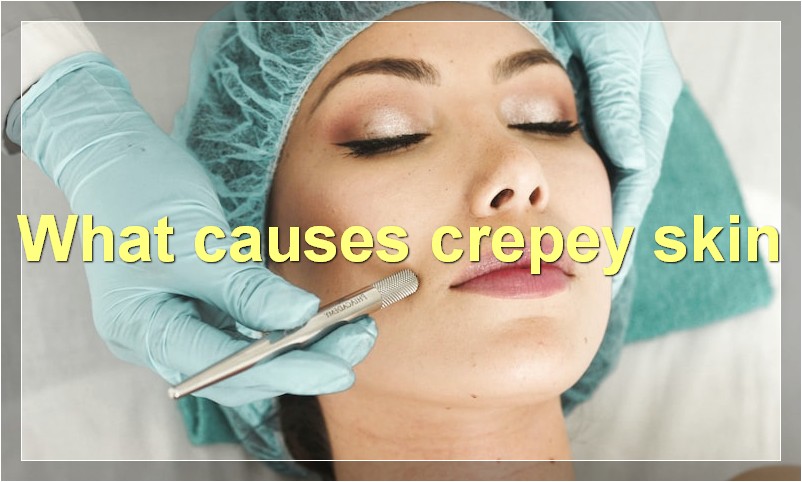and Symptoms of Diabetes}
Did you know that diabetes is one of the leading causes of death in the United States? According to the Centers for Disease Control and Prevention (CDC), more than 29 million Americans have diabetes. That’s about one in every ten people! And, the CDC also reports that one in four people with diabetes don’t even know they have it. Diabetes is a serious disease that can lead to a number of health complications, including heart disease, stroke, kidney disease, blindness, and amputation. The good news is that there are treatments available to help people manage their diabetes and live long, healthy lives. In this article, we will discuss nine treatments, causes, and symptoms of diabetes.
What are some effective treatments for crepey skin
As we age, our skin loses elasticity and becomes thinner, drier, and less able to protect itself from damage. This process is accelerated by sun exposure, smoking, and poor nutrition. The resulting skin condition, known as crepey skin, is characterized by wrinkles, sagging, and a papery texture.
There are several effective treatments for crepey skin. Topical retinoids, such as tretinoin (Retin-A), help to stimulate collagen production and improve skin thickness. Alpha hydroxy acids (AHAs), such as glycolic acid, improve moisture retention and reduce the appearance of wrinkles. Peptides are another effective ingredient, as they help to boost collagen production and prevent the breakdown of existing collagen. Sunscreen is also an important part of any anti-aging skincare regimen, as it helps to protect the skin from further damage.
If you are concerned about the appearance of crepey skin, talk to your dermatologist about the best treatment options for you.
What causes crepey skin

The causes of crepey skin are many and varied. sun damage, smoking, poor nutrition, dehydration, and certain medical conditions can all lead to the development of crepey skin.
Sun damage is one of the most common causes of crepey skin. The ultraviolet rays from the sun can damage the collagen and elastin fibers in the skin, leading to a loss of elasticity and a decrease in collagen production. This can result in the formation of fine lines and wrinkles, as well as sagging skin.
Smoking is another major cause of crepey skin. The chemicals in tobacco smoke damage the collagen and elastin fibers in the skin, causing them to break down. This leads to a loss of elasticity and firmness, as well as the formation of wrinkles.
Poor nutrition can also lead to crepey skin. A diet that is lacking in essential vitamins and minerals can cause the skin to become dry and lifeless. This can lead to a loss of elasticity and firmness, as well as the formation of wrinkles.
Dehydration is another common cause of crepey skin. When the skin is not properly hydrated, it can become dry and cracked. This can lead to a loss of elasticity and firmness, as well as the formation of wrinkles.
Certain medical conditions can also cause crepey skin. Conditions such as diabetes, thyroid problems, and menopause can all lead to a decrease in collagen production. This can result in the formation of fine lines and wrinkles, as well as sagging skin.
How can I prevent crepey skin from forming
Crepey skin is a condition characterized by thin, fragile skin that has a wrinkled and saggy appearance. It is most commonly seen on the face, neck, hands, and arms. While crepey skin can be caused by a number of factors, including sun damage and aging, there are some things you can do to prevent it from forming.
Here are four tips to help prevent crepey skin:
1. Use sunscreen.
One of the best ways to prevent crepey skin is to use sunscreen regularly. Be sure to choose a sunscreen with an SPF of 30 or higher and apply it liberally to all exposed areas of skin. Reapply every two hours, or more often if you are sweating or swimming.
2. Avoid smoking.
Smoking contributes to crepey skin by reducing the production of collagen and elastin, two proteins that keep skin firm and elastic. If you smoke, quitting is one of the best things you can do for your skin—and your overall health.
3. Eat a healthy diet.
Eating a diet that is rich in antioxidants, like fruits, vegetables, and whole grains, can help protect your skin from damage that can lead to crepey skin.
4. Keep your skin hydrated.
Drinking plenty of water and using a moisturizer will help keep your skin hydrated and may help prevent crepey skin.
Is there a way to tighten crepey skin
As we age, our skin loses elasticity and becomes thinner, which can result in crepey skin. This often happens first on our face, neck, and hands—areas that are most exposed to the sun. While there are a number of factors that contribute to crepey skin, including genetics and environmental damage from sun exposure and pollution, the main cause is simply the loss of collagen and elastin—two proteins that give our skin its youthful firmness and elasticity.
There are a number of ways to treat crepey skin, including topical treatments, laser therapy, and surgery. Topical treatments include retinoids, vitamin C serums, hyaluronic acid, and copper peptides. These ingredients help to stimulate collagen production, increase cell turnover, and improve hydration. Laser therapy uses intense pulsed light or fractional lasers to stimulate collagen production and improve skin texture. Surgery is usually only recommended for severe cases of crepey skin.
If you’re concerned about crepey skin, talk to your dermatologist about the best treatment options for you. In the meantime, there are a few things you can do to prevent it from getting worse. First, protect your skin from the sun by applying sunscreen every day and wearing protective clothing when you’re outdoors. Second, avoid smoking and excess alcohol consumption, as these can both contribute to skin damage. Finally, eat a healthy diet and stay hydrated to help keep your skin looking its best.
How do I get rid of the wrinkles in my crepey skin
As we age, our skin goes through a lot of changes. We get wrinkles, we get crepey skin, and sometimes, it can be hard to know how to deal with it. But don’t worry, there are some things you can do to help reduce the appearance of wrinkles and crepey skin.
First, let’s talk about wrinkles. There are a few things that can cause wrinkles, but one of the biggest culprits is sun damage. So, if you want to reduce the appearance of wrinkles, it’s important to protect your skin from the sun. You can do this by wearing sunscreen every day, even when it’s cloudy outside.
Another thing that can cause wrinkles is smoking. If you smoke cigarettes, it’s time to quit. Smoking causes your skin to produce less collagen, which leads to wrinkles.
So, how do you get rid of wrinkles? There are a few options. You can try anti-wrinkle creams or serums, you can get injections of botulinum toxin (Botox), or you can have laser treatments.
If you want to go the natural route, there are a few things you can do to help reduce the appearance of wrinkles. You can use coconut oil or almond oil as a natural moisturizer. You can also try using avocado oil or olive oil as a natural wrinkle treatment. Just massage a small amount into your skin each day and you should see a difference over time.
Now let’s talk about crepey skin. Crepey skin is thin and delicate skin that tends to sag and wrinkle easily. It’s often caused by sun damage or smoking, just like wrinkles.
So, how do you get rid of crepey skin? Again, there are a few options. You can use anti-aging creams or serums, you can get laser treatments, or you can try some natural remedies.
To naturally treat crepey skin, you can try using coconut oil or almond oil as a moisturizer. You can also try using avocado oil or olive oil as a natural treatment. Just massage a small amount into your skin each day and you should see a difference over time.
If you’re looking for a more immediate solution, you can always try getting injections of botulinum toxin (Botox). Botox is a safe and effective way to temporarily smooth out the appearance of wrinkles and creases in the skin.
No matter what method you choose, it’s important to be patient. Treatments like Botox take time to work and natural remedies may take several weeks to show results. But if you’re persistent, you’ll eventually see a reduction in the appearance of wrinkles and crepey skin.
What is the best way to moisturize crepey skin

As we age, our skin changes. The once smooth and firm skin on our face and bodies begins to thin and sag. We start to see wrinkles, fine lines, and other blemishes that weren’t there before. A lot of this is due to a loss of collagen and elastin in the skin. But there’s another factor that can contribute to premature aging skin: crepey skin.
What is crepey skin?
Crepey skin is thin, wrinkled, and often feels papery to the touch. It’s a common problem in older adults, but it can also happen to younger people who have overexposed their skin to the sun or other environmental factors. Crepey skin is more prone to damage and is less able to bounce back after being stretched or pinched.
What causes crepey skin?
There are several factors that can contribute to the development of crepey skin:
Age: As we age, our skin naturally becomes thinner and less elastic. This process is accelerated by exposure to ultraviolet (UV) light from the sun or tanning beds.
Weight loss: Sudden weight loss can cause your skin to sag and become crepey. This is because when you lose weight, your skin doesn’t have time to adjust and adapt to your new shape.
Smoking: Smoking damages the collagen and elastin in your skin, which leads to premature aging.
Dehydration: If you don’t drink enough water, your skin can become dry and wrinkled. This is because water helps keep your skin cells plump and hydrated.
How can I prevent crepey skin?
Unfortunately, there’s no way to completely prevent crepey skin. However, there are some things you can do to slow down the process and keep your skin looking its best:
Wear sunscreen: UV rays accelerate the aging process by damaging the collagen in your skin. Wearing sunscreen with an SPF of 30 or higher can help protect your skin from these harmful rays. Be sure to reapply every two hours, or more often if you’re sweating or swimming.
Don’t smoke: Smoking damages the collagen in your skin, leading to premature wrinkles and sagging skin. If you smoke, quitting is one of the best things you can do for your skin—and your overall health.
Stay hydrated: Drinking plenty of water helps keep your skin cells plump and hydrated. Aim for eight glasses of water a day.
Eat healthy: Eating a healthy diet helps your body function at its best—including your skin. Be sure to include plenty of fruits, vegetables, lean protein, and healthy fats in your diet.
Can sun exposure help improve crepey skin
When it comes to improving crepey skin, sun exposure is often thought of as a necessary evil. But new research suggests that getting some sun may actually be beneficial for this common skin issue.
Crepey skin is characterized by thin, wrinkles skin that often has a crumpled or sagging appearance. It’s a common problem as we age, but can also be caused by sun damage, smoking, dehydration, and other factors.
While there’s no surefire way to get rid of crepey skin, there are things you can do to improve its appearance. One of the most effective treatments is retinol, which is a form of vitamin A that helps stimulate collagen production and promote cell turnover.
Sun exposure can also help improve crepey skin. The UV rays help stimulate collagen production and increase cell turnover. This can help thicken the skin and reduce the appearance of wrinkles and fine lines.
Of course, too much sun exposure can also be harmful, so it’s important to balance your time in the sun with other activities that will protect your skin. Wearing sunscreen, staying hydrated, and avoiding smoking are all important for maintaining healthy skin.
If you’re concerned about the appearance of your crepey skin, talk to your dermatologist about the best treatment options for you.
Are there any home remedies for crepey skin
As we age, our skin goes through many changes. One common change is the development of crepey skin. This type of skin is thin, wrinkled, and often looks like crinkled tissue paper. While there are many commercial products available to help improve the appearance of this type of skin, there are also some simple home remedies that can be used.
One popular home remedy for crepey skin is to apply a mixture of baking soda and water. This mixture can help to exfoliate the skin and improve its overall appearance. Another home remedy that is often used is to apply a thin layer of petroleum jelly to the affected area. This can help to moisturize the skin and make it appear smoother.
If you are looking for a more natural approach to improving the appearance of your crepey skin, there are also some essential oils that can be used. Some good options include lavender oil, chamomile oil, and rosehip oil. These oils can be added to a carrier oil such as jojoba oil or almond oil and then massaged into the skin.
While there is no one perfect solution for crepey skin, these home remedies can help to improve its appearance. If you are not seeing the results you would like, you may want to consider talking to a dermatologist about other options that may be available.
What are some tips for dealing with crepey skin
As we age, our skin naturally becomes thinner and less elastic. This can lead to the development of fine lines and wrinkles, as well as a condition called crepey skin.
Crepey skin is characterized by a thin, crinkly appearance that is similar to crepe paper. It can occur anywhere on the body, but is most commonly seen on the face, neck, arms, and legs.
While there is no way to completely prevent crepey skin, there are some things you can do to minimize its appearance.
Here are 4 tips for dealing with crepey skin:
1. Use a gentle cleanser.
Avoid using harsh soaps or cleansers on your skin. Instead, opt for a gentle, non-irritating product. This will help to avoid further damage and keep your skin feeling smooth and hydrated.
2. Apply a moisturizer daily.
A good moisturizer will help to plump up your skin and give it a more youthful appearance. Be sure to choose a product that is suitable for your skin type and apply it liberally to all areas of your body where crepey skin is present.
3. Use a sunscreen.
Protecting your skin from the sun’s harmful rays is important at any age, but it’s especially crucial if you have crepey skin. Choose a sunscreen with an SPF of 30 or higher and apply it generously before spending time outdoors.
4. Consider professional treatments.
If home care measures aren’t improving the appearance of your crepey skin, consider seeking out professional treatments such as laser resurfacing or microdermabrasion. These procedures can help to improve the texture and tone of your skin with minimal downtime.
Is there a cure for crepey skin
Crepey skin is a common problem that can occur as we age. The skin becomes thinner and less elastic, which can cause it to develop wrinkles and creases. There are a number of factors that can contribute to the development of crepey skin, including sun damage, smoking, dehydration, and poor nutrition.
While there is no cure for crepey skin, there are a number of things you can do to help improve its appearance. These include using a sunscreen with an SPF of 30 or higher, avoiding smoking, staying hydrated, and eating a healthy diet. You can also try using topical treatments, such as retinoids, vitamin C, or hyaluronic acid. If your crepey skin is particularly severe, you may want to consider getting laser resurfacing or another type of cosmetic procedure.





